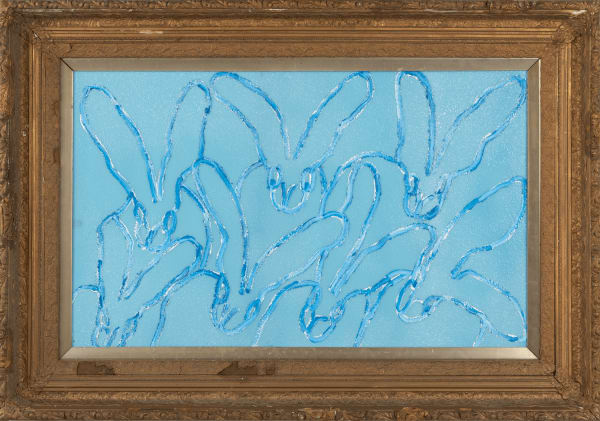Hunt Slonem
American, b. 1951
Hunt Slonem (born July 18, 1951, Kittery, Maine) is an American painter, sculptor, and printmaker who has lived and worked in New York since the early 1970s. Raised in a Navy family that moved frequently and spending a pivotal exchange year in Nicaragua in 1968, he absorbed tropical color and fauna that later became the core of his imagery. He studied at Vanderbilt University, the Universidad de las Américas in Mexico, and the Skowhegan School of Painting & Sculpture (1972), earning a B.A. in painting and art history from Tulane University in 1973 before relocating to Manhattan; early milestones include a Greenshields grant (1976), a formative summer working in Janet Fish’s studio (1975), and first New York solo shows (1977). Across the 1980s he consolidated the serial language for which he is best known—rabbits, birds, and butterflies—painted in vivid, saturated palettes with thick impasto and rhythmic, incised cross-hatching (a sgraffito-like mark that aerates the surface), often set in ornate antique frames he avidly collects. The birds are grounded in daily observation: Slonem maintains a large personal aviary of parrots and other tropical species, and his studio routine—repeating motifs in swift, almost calligraphic sessions—gives the work its devotional cadence. His painting references neo-expressionist energy and Pop-era repetition without quotation; gold-leaf grounds, jewel-toned fields, and patterned “wall” compositions push his images toward the scale and shimmer of ornament, while freestanding sculpture, installations, and design collaborations extend his vocabulary into space. Among early advocates was curator Henry Geldzahler, who championed the clarity of Slonem’s painterly instinct and serial discipline. A prominent public commission—the 86-foot bird mural for New York’s Bryant Park Grill (1995)—signaled the immersive scale he would continue to explore. Slonem is also a voracious collector and preservationist who has acquired and restored multiple nineteenth-century properties, filling them with Victorian furniture, ecclesiastical fragments, and other historical objects, environments that mirror the maximal, time-layered sensibility of his art.
His work is represented in over 250 museum collections worldwide, including the Metropolitan Museum of Art, the Brooklyn Museum, the Solomon R. Guggenheim Museum, the Whitney Museum of American Art, the Smithsonian American Art Museum, the United States Capitol, the Fundació Joan Miró (Barcelona), the New Museum (New York), the Würth Museum (Künzelsau), and numerous U.S. embassies. Notable recent and mid-career exhibitions include The Bunny Wall at Palazzo Bembo during the 60th Venice Biennale (2024); museum presentations at the Polk Museum of Art (2024) and the Albany Institute of History & Art (2024); a retrospective at the Cabildo/Louisiana State Museum, New Orleans (2023–24); Bank Austria Kunstforum Wien, Vienna (2023); Osthaus Museum, Hagen (2022); Art Museum Riga Bourse, Riga (2022); exhibitions at the Daugavpils Mark Rothko Art Center and Jelgava, Latvia (2020); HUNTOPIA at the Taubman Museum of Art, Roanoke (2019–20); Nassau County Museum of Art, Roslyn Harbor (2018); A. Kasteev State Museum of Arts and the National Museum of the Republic of Kazakhstan (2018); the State Russian Museum, St. Petersburg (2017); the LSU Museum of Art, Baton Rouge (2016); the Moscow Museum of Modern Art and the Russian Academy of Arts (2015); and the Fort Wayne Museum of Art (2014–15). He continues to work in Manhattan, producing paintings, prints, sculpture, and installations that fuse serial repetition, tactile facture, and a sustained engagement with nature and history.
-
Slonem's Animal Paintings
Selected Works-
 Hunt Slonem, Banded Purple, 2016
Hunt Slonem, Banded Purple, 2016 -
 Hunt Slonem, Friends Macaws, 2018
Hunt Slonem, Friends Macaws, 2018 -
 Hunt Slonem, Night Watch Blue, 2023
Hunt Slonem, Night Watch Blue, 2023 -
 Hunt Slonem, Red Motmot, 2022
Hunt Slonem, Red Motmot, 2022
-
 Hunt Slonem, Resin Kaleidoscope Butterflies, 2021
Hunt Slonem, Resin Kaleidoscope Butterflies, 2021 -
 Hunt Slonem, Starry Night Silent, 2021
Hunt Slonem, Starry Night Silent, 2021 -
 Hunt Slonem, Supreme, 2020
Hunt Slonem, Supreme, 2020 -
 Hunt Slonem, Tiger Swallow Tails, 2021
Hunt Slonem, Tiger Swallow Tails, 2021
-
 Hunt Slonem, Trogon, 2020
Hunt Slonem, Trogon, 2020 -
 Hunt Slonem, Crimson Gift, 2021
Hunt Slonem, Crimson Gift, 2021 -
 Hunt Slonem, Finches, 2013
Hunt Slonem, Finches, 2013 -
 Hunt Slonem, Lagoon, 2019
Hunt Slonem, Lagoon, 2019
-
-
Further Reading and Information
Slonem Kunstforum Museum Catalogue
Essays and Interviews
-
“Birds Behind Bars (and Some Are Real)” — Vivien Raynor — The New York Times — Nov 18,1990
-
Henry Geldzahler on Hunt Slonem — Foreword from Hunt Slonem — 1993
-
“A Canvas of 100 Rooms” — Claudia Steinberg — The New York Times — July 22, 2004
-
“Southern Gothic: Ghosts Welcome” — Joyce Wadler — The New York Times — May 31, 2007
-
“An Oddball Menagerie” — Kelly Crow — The Wall Street Journal — Nov 19, 2011
-
“Journey into Wonderland: An Interview with Hunt Slonem” — The Glam Pad — Mar 3, 2021
-
“Hunt Slonem Interview” — Roxanne Adamiyatt — Town & Country — Mar 24, 2021
Comprehensive Collection of Publications Featuring Slonem: “Publications” — Hunt Slonem Studio
Videos: “Media” — Hunt Slonem Studio
Artist’s Full CV: “Resume (shows, collections, achievements)” — Hunt Slonem Studio -


















